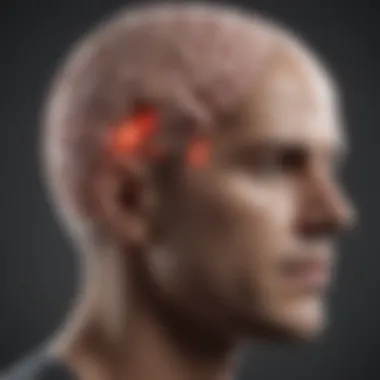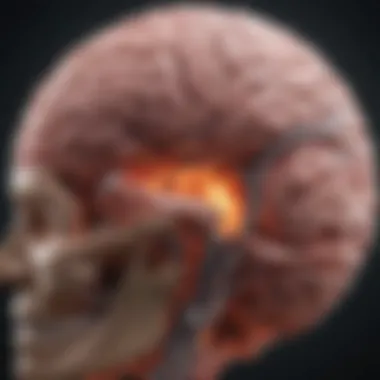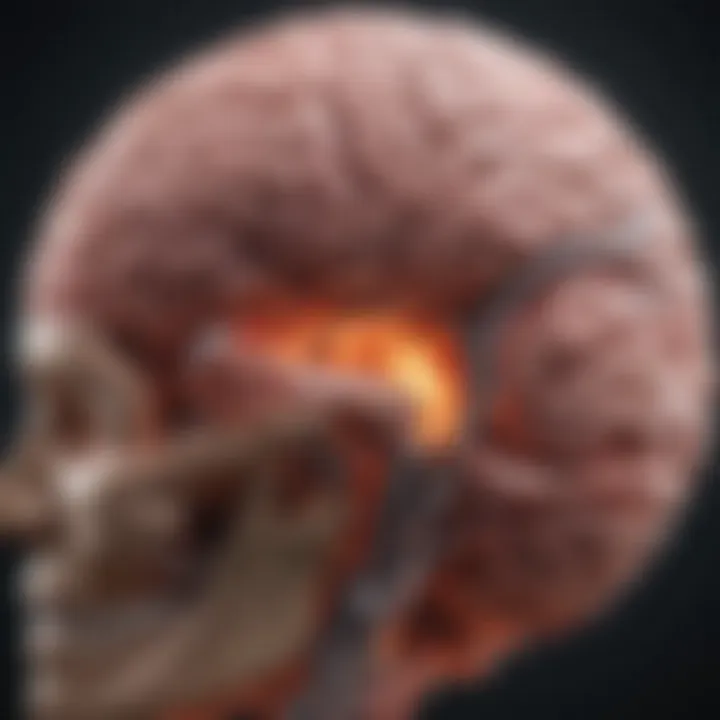Understanding Secondary Brain Tumors: A Comprehensive Overview


Intro
Secondary brain tumors, or metastatic brain tumors, represent a critical area of study within neuro-oncology. These tumors arise when malignant cells from other parts of the body spread to the brain. Unlike primary brain tumors, which originate in the brain itself, secondary tumors indicate a more complex underlying malignancy. This condition necessitates a comprehensive understanding of its implications for diagnosis, management, and patient care.
The following sections explore the various facets of secondary brain tumors. These include the pathophysiological mechanisms that allow tumors to migrate to the brain, the types of cancers often responsible, diagnostic modalities employed, available treatments, and how these tumors can significantly impact a patient's neurological function and quality of life. By addressing these aspects, the article provides essential information for students, educators, researchers, and professionals interested in the complexities of secondary brain tumors and their broader implications.
Prelims to Secondary Brain Tumors
The exploration of secondary brain tumors is critical to understanding the broader landscape of neuro-oncology. Secondary brain tumors, which arise from cancer cells that have metastasized from other organs, present unique challenges in both research and clinical practices. Comprehending the nature and implications of these tumors helps elucidate the complexity of cancer treatment and its impact on neurological health.
Definition and Terminology
Secondary brain tumors are commonly referred to as metastatic brain tumors. They originate from malignant cells that migrate to the brain from primary tumors located in other parts of the body. This migration occurs through the bloodstream or lymphatic system. Definitionally, it is essential to distinguish these metastatic tumors from primary brain tumors, which begin within the brain itself. Understanding this distinction aids healthcare professionals in developing appropriate treatment strategies and provides clarity to patients regarding their diagnosis.
The terminology surrounding secondary brain tumors can be complicated. Key terms include:
- Metastasis: The process by which cancer cells spread from the primary site to other locations.
- Oncogenesis: The formation of tumors, which may be pertinent in understanding how certain cancers predispose individuals to metastasize.
- Neuropathology: This term refers to the study of diseases of the nervous system, including the effects secondary tumors have on brain tissue.
Epidemiology and Prevalence
The epidemiology of secondary brain tumors reveals important insights into their prevalence and clinical significance. Recent studies indicate that secondary brain tumors are found in approximately 20-40% of patients with known metastatic cancer. In adults, the most common primary tumors leading to brain metastasis include lung cancer, breast cancer, melanoma, and colorectal cancer. In younger populations, tumors such as neuroblastoma are more frequent.
The incidence of secondary brain tumors is increasing, with advances in imaging techniques and cancer treatments allowing for earlier detection and improved management. Factors such as age, gender, and the specific type of primary cancer play a vital role in determining an individual’s likelihood of developing secondary brain tumors. Furthermore, advances in oncology underline the necessity of tracking secondary brain tumors to inform clinical decisions and enhance patient outcomes.
Understanding these statistics and trends is pivotal. Higher awareness among healthcare providers can lead to better monitoring and more tailored treatment plans for at-risk populations, thereby improving overall patient care.
Types of Secondary Brain Tumors
Understanding the types of secondary brain tumors is essential for grasping the broader implications of metastatic disease. This section serves to illuminate the characteristics, sources, and classifications of these tumors, thereby enhancing knowledge for both patients and professionals. By defining the origins and types of metastasis, we can tailor prevention and treatment strategies effectively, ensuring better patient outcomes.
Common Sources of Metastasis
Breast Cancer
Breast cancer is one of the leading causes of secondary brain tumors. The prevalence of breast cancer in women, alongside its tendency to metastasize to the brain, makes it a critical focus. The unique feature of breast cancer is its capacity to spread through lymphatic and hematogenous routes. This characteristic underscores the importance of early detection and treatment, as the brain can serve as a sanctuary site for metastatic cells.
The key characteristic is that breast cancer can often remain asymptomatic until it reaches an advanced stage. This can complicate treatment and affect prognosis negatively. Thus, understanding its pathways is beneficial for early intervention strategies, which may ultimately improve survivorship.
Pulmonary Carcinoma
Pulmonary carcinoma is notable due to its aggressive nature and high incidence rate. It often spreads to the brain, making it a pertinent topic for discussion. The distinctive feature of pulmonary carcinoma is that it usually presents with significant symptoms, such as persistent cough or blood in sputum, which can expedite diagnosis. This can be advantageous, as symptoms might lead to earlier imaging and treatment.
However, the downside is that the cancer can be difficult to treat once it has metastasized, complicating the overall management of patients.
Melanoma
Melanoma is known for its high metastatic potential. This skin cancer can quickly spread to various organs, including the brain. A key characteristic of melanoma is its notorious ability to evade the immune response. This unique feature necessitates an aggressive therapeutic approach, often combining surgical resection with immunotherapy and targeted therapy.
This multi-modal strategy is an important consideration, as it reflects an evolution in treatments specific to melanoma. Yet, this aggressive behavior of melanoma also poses significant challenges in terms of prognosis and potential recurrence.
Colorectal Cancer
Colorectal cancer has emerged as another frequent contributor to secondary brain tumors. The spread to the brain can occur at an advanced stage or even during treatment in some cases. Its key characteristic is its fibrous nature, which can make detection of metastasis complex.
The unique feature of colorectal cancer is that it can be influenced by lifestyle factors, creating avenues for preventative measures. However, once metastasized, treatment becomes far more complicated and requires advanced intervention techniques.
Renal Cell Carcinoma
Renal cell carcinoma is another significant source of brain metastases. It is infamously known for its tendency to metastasize to the brain, along with other distant organs. The key characteristic of renal cell carcinoma is its propensity to grow in a vascular-rich environment, facilitating its spread.
The unique feature of renal cell carcinoma involves the mechanisms of renal systemic circulation, which plays a role in its ability to seed tumors in the brain. Although there are treatment modalities available, the late presentation often results in a grim prognosis.
Classification by Histology
Carcinomatous Tumors


Carcinomatous tumors are characterized by their origin from epithelial cells. Their presence can indicate aggressive metastatic behavior and poor prognosis. The key feature of this classification is its differentiated nature, which can pose challenges for treatment, especially when identifying the primary source. The harmful potential of these tumors emphasizes the need for precise diagnosis and stratified treatment plans.
Neuroblastoma
Neuroblastoma is primarily a childhood cancer but can present unique challenges when it metastasizes to the brain. It is derived from neuroectodermal tissue and typically presents a more complex pathology. The key characteristic of neuroblastoma is its ability to arise from sympathetic nervous tissue, which can complicate treatment due to its location.
The unique feature lies in its varied clinical presentations, which necessitate a multifaceted approach for treatment. Variability in response to therapies makes this a vital area for continued research.
Other Variants
Other variants of secondary brain tumors can be classified based on their unique histological characteristics. This includes variations that may not fit neatly into the previous categories yet carry significant implications. The key characteristic is the heterogeneity observed within these tumors, reflecting a diverse clinical picture.
Understanding these variants allows for broader considerations in treatment plans, recognizing the need for personalized and adaptable strategies. Their impact on overall outcomes highlights the importance of ongoing research in this area.
Pathophysiology of Secondary Brain Tumors
Understanding the pathophysiology of secondary brain tumors is crucial in developing effective strategies for diagnosis and treatment. This section aims to elucidate how these tumors arise and how they interact with the surrounding brain tissue. Each aspect discussed here provides insight into the cancer's behavior and its effects on neurological function.
Mechanisms of Metastasis
Metastasis refers to the process by which cancer cells spread from their original site to other parts of the body, including the brain. This phenomenon plays a significant role in secondary brain tumors. The mechanisms can be outlined in several key steps:
- Invasion: Cancer cells invade nearby tissues. This invasion can happen through extracellular matrix degradation, allowing cancer cells to penetrate surrounding areas.
- Circulation: Once in the local tissue, they can enter blood vessels. This allows them to circulate through the body.
- Extravasation: The cancer cells then exit the blood vessels at the target organ, like the brain. They adhere to the endothelial cells lining the vessels and eventually cross the blood-brain barrier, a significant hurdle for many substances, including drugs.
- Proliferation in the new site: Once they survive this journey, they may start to grow in the new environment. Factors such as growth factors and immune response at the new site can influence this proliferation.
The route of these mechanisms highlights the complex interplay between cancer biology and the body’s physiological responses. This understanding facilitates the development of targeted therapies that aim to interrupt specific stages of this metastatic process.
Effects on Brain Tissue
The arrival of metastatic cells in the brain leads to various changes in the brain tissue. These effects can be significant:
- Disruption of normal function: Secondary brain tumors can disrupt the normal functioning of brain cells. This leads to neurological deficits, depending on the tumor’s location. Common issues include seizures, speech difficulties, and motor impairments.
- Edema: Tumors often cause edema, which is the accumulation of excessive fluid in the brain. Swelling can increase intracranial pressure, causing headaches and further complicating neurological function.
- Treatment implications: Understanding how brain tissue is affected can guide treatment decisions. For example, tumor-induced alterations may determine the appropriateness of surgical interventions.
Emphasizing the pathophysiological aspects of secondary brain tumors provides a foundation for comprehending the complexities of neuro-oncology. This knowledge is essential for advancing research and clinical approaches in this field.
Clinical Presentation
The clinical presentation of secondary brain tumors represents a critical area within neuro-oncology. This section highlights common symptoms that can emerge as a result of tumors that metastasize to the brain. Recognizing these symptoms is essential for timely diagnosis and appropriate management. Early identification can influence patient outcomes significantly. Understanding symptoms aids healthcare professionals in differentiating secondary brain tumors from other neurological conditions.
Common Symptoms and Signs
Headaches
Headaches are one of the most frequent complaints in patients with secondary brain tumors. They often present as new or changed headache patterns. The key characteristic is their persistent or progressive nature. This can indicate increased intracranial pressure or other complications, prompting further investigation.
The reason headaches are a prominent focus in this discussion is their widespread occurrence. Approximately 20 to 30 percent of patients with brain metastatic disease report headaches as one of their primary symptoms. Moreover, headaches that differ in intensity or frequency from the individual’s typical headache patterns can serve as significant indicators of an underlying issue. However, it is important to recognize that not all headaches indicate a tumor, and other factors may cause similar symptoms.
Neurological Deficits
Neurological deficits encompass a range of impairments resulting from secondary brain tumors. These may include motor weakness, sensory loss, and difficulties with coordination. The key characteristic of neurological deficits is their ability to indicate the location and extent of the tumor's effects on brain function.
This topic is particularly crucial because neurological deficits often necessitate immediate clinical evaluation. Patients may experience deficits that can significantly affect their quality of life. For example, unilateral weakness can impact mobility and the ability to perform daily tasks. The unique feature of these deficits is their variability, depending on the specific areas of the brain affected. This can make diagnosis challenging and requires careful assessment by healthcare professionals.
Cognitive Changes
Cognitive changes can include memory deficits, confusion, and alterations in judgment. These changes arise due to the tumor's impact on cognitive processing areas in the brain. A key characteristic of cognitive changes is their gradual onset, which can lead to misinterpretation or delay in seeking help until significant impairment occurs.
Cognitive changes are relevant in the context of this article as they can deeply affect the patient’s daily life and interactions. These changes often challenge healthcare providers in terms of developing effective treatment plans. A unique aspect of cognitive changes is that they can be misattributed to stress or aging, which may impede timely diagnosis. Being aware of these changes is vital for both patients and healthcare providers, ensuring necessary evaluations are conducted.
Differentiation from Primary Brain Tumors
Differentiating secondary brain tumors from primary brain tumors is fundamental for determining the correct treatment approach. Both types of tumors exhibit overlapping symptoms, yet their origins differ significantly. Healthcare professionals must utilize imaging techniques, biopsy samples, and clinical history to distinguish between the two.
Differences in treatment modalities between secondary and primary tumors are also essential in clinical practice. Understanding these distinctions aids in optimizing therapy, guiding prognosis, and improving overall patient management. In summary, an accurate differentiation is key to effective treatment strategies, impacting patient outcomes and quality of life.
Diagnosis and Assessment


The diagnosis and assessment of secondary brain tumors are crucial in guiding effective treatment plans and predicting patient outcomes. These tumors, which arise from metastasized cancer cells, present unique challenges. Accurate and timely diagnosis can significantly influence the management strategy and help improve the quality of life for patients. Understanding the methods involved in diagnosing these tumors is key, as it encompasses both imaging techniques and histological evaluations.
Neuroimaging Techniques
Neuroimaging plays a pivotal role in identifying the presence and extent of secondary brain tumors. It includes several imaging modalities, each with distinct advantages and limitations that contribute to the overall evaluation process.
MRI
Magnetic Resonance Imaging (MRI) is a powerful tool in neurology. It provides detailed images of brain structures and is particularly adept at detecting soft tissue abnormalities. One of the key characteristics of MRI is its ability to generate high-resolution images without the use of ionizing radiation, making it a safer choice compared to other imaging methods. An important feature of MRI is its sensitivity in differentiating between tumor types, thus providing insights into treatment decisions. The disadvantages, however, include longer scanning times and potential discomfort for some patients, such as those with claustrophobia.
CT Scans
Computed Tomography (CT) scans offer a rapid assessment of brain lesions. They are immensely beneficial for emergency settings, where speed is crucial. The key characteristic of CT scans is their wide availability and ability to visualize bony structures alongside soft tissue. This dual capability aids in identifying complications like hemorrhage associated with tumors. However, CT scans employ ionizing radiation, posing a concern for cumulative radiation exposure especially in young patients. Their lower sensitivity for small lesions compared to MRI may lead to missed diagnoses.
PET Scans
Positron Emission Tomography (PET) scans are vital for functioning assessments and metabolic activity visualization in tissues. The unique aspect of PET scans is their ability to differentiate between benign and malignant processes based on cellular metabolism. They provide complementary information to MRI and CT scans, particularly in identifying active tumor areas. However, the disadvantage lies in their limited spatial resolution, which may not localize tumors as precisely as MRI or CT scans.
Biopsy Procedures
Biopsy procedures are integral in confirming the diagnosis of secondary brain tumors. They allow for direct tissue sampling, enabling pathologists to assess the type of cancer and determine specific characteristics that can influence treatment. There are various methods for biopsies, including stereotactic and open biopsies, each with different risk levels and implications for patients. The choice of biopsy method often depends on the tumor's location, size, and overall patient condition.
The importance of accurate biopsy results cannot be overstated, as they not only assist in diagnosis but also facilitate personalized treatment approaches based on tumor morphology and genetic profiling.
Accurate diagnosis and assessment are vital for effective treatment and management of secondary brain tumors.
Treatment Options
The treatment options for secondary brain tumors are crucial in crafting a comprehensive care plan. These tumors arise due to metastasis, making management multifaceted. Addressing these tumors often involves a combination of surgery, radiation therapy, and chemotherapy. This section explores each treatment modality’s role, benefits, and specific considerations essential for patient care and outcomes.
Surgical Interventions
Surgical interventions serve as a primary method to manage secondary brain tumors when feasible. The main goal is often to remove as much of the tumor as possible. A complete resection can alleviate symptoms and potentially improve the patient’s quality of life. However, surgery might not always be viable due to tumor location or patient health conditions.
Key benefits of surgical interventions include:
- Symptom Relief: Reducing mass effects, such as pressure on surrounding brain structures.
- Diagnostic Purposes: Tissue samples obtained during surgery assist in confirming the tumor's pathology.
Considerations must include risks such as bleeding, infection, and neurological deficits. An individualized approach, factoring in tumor type and patient circumstances, is essential.
Radiation Therapy
Radiation therapy plays a significant role in the management of secondary brain tumors, often complementing surgical options. This method employs targeted radiation to destroy tumor cells while sparing healthy tissue as much as possible.
Whole Brain Radiation
Whole brain radiation therapy (WBRT) is a treatment particularly relevant for patients with multiple metastases. It aims to deliver a uniform dose of radiation to the entire brain. A key characteristic is its non-invasive nature, making it a good option for those who may not tolerate surgery well.
Benefits of WBRT include:
- Widespread Treatment: Effective for numerous tumors across the brain.
- Symptomatic Improvement: Can reduce headaches and seizures associated with tumor pressure.
However, it has potential disadvantages, such as:
- Cognitive Side Effects: Some patients experience memory loss and cognitive decline over time.
- Risk of Fatigue: Common during treatment, impacting overall quality of life.
Stereotactic Radiosurgery
Stereotactic radiosurgery (SRS) offers a precise alternative for treating well-defined lesions. It allows high doses of radiation to be focused on tumor sites in fewer sessions. One distinctive feature is its non-invasive approach, making recovery generally quicker than traditional surgery.
Advantages of SRS include:
- Precision: Minimally impacts surrounding healthy brain tissue, reducing potential side effects.
- Convenience: Fewer treatment sessions enhance patient compliance and convenience.
Disadvantages, on the other hand, may include:


- Limited to Small Tumors: Effectiveness decreases for larger or infiltrative tumors.
- Need for Advanced Imaging: Requires detailed imaging for optimal targeting, which may not always be available.
Chemotherapy and Targeted Therapies
Chemotherapy offers a systemic approach to treat underlying malignancies causing secondary brain tumors. Traditional chemotherapeutics target rapidly dividing cells, including cancer cells. However, the blood-brain barrier can limit the effectiveness of many chemotherapy agents.
Targeted therapies, conversely, focus on specific molecular targets associated with tumor growth and spread. These therapies can lead to improved outcomes with potentially reduced side effects compared to conventional chemotherapy.
In summary, selecting the appropriate treatment for secondary brain tumors requires careful consideration of multiple factors, including the tumor's behavior, patient health, and desired outcomes. Optimizing these treatment options can significantly impact the management and overall quality of life for patients.
Research and Future Directions
Research into secondary brain tumors is crucial for several reasons. First, the complexity of these tumors requires ongoing investigation into their biology and behavior. A deeper understanding can lead to more effective treatment options. Secondary brain tumors often present unique challenges due to their origin from various cancers and their impact on neurological functions. Thus, research outcomes directly influence clinical practices and patient outcomes.
Innovative Treatment Modalities
Innovative treatment modalities are emerging in the realm of managing secondary brain tumors. These approaches aim to optimize patient outcomes through a combination of existing therapies and novel techniques. One notable advancement is the use of immunotherapy, which harnesses the body’s immune system to combat tumor growth. This approach has shown promise in various cancer types, potentially enhancing survival rates for patients with brain metastases.
In addition, targeted therapies are being developed to focus on specific genetic alterations present in the tumor cells. For example, drugs targeting mutations associated with breast cancer or lung cancer expand the therapeutic landscape for patients with secondary brain tumors originating from these sites. Furthermore, the integration of advanced surgical techniques, such as intraoperative imaging and navigation systems, improving surgical precision and minimizing damage to surrounding healthy tissue, has become more prevalent.
Clinical Trials and Studies
Clinical trials represent a critical aspect of advancing knowledge about secondary brain tumors. These studies help evaluate the effectiveness of new treatment strategies and provide insights into the tumor’s biology. Participation in clinical trials allows patients access to cutting-edge therapies that may not yet be widely available.
Moreover, data gathered from trials contribute to a growing repository of information, enabling researchers to identify trends and improve understanding of which treatments may offer the best outcomes for specific patient populations. Ongoing collaboration between academic institutions, healthcare providers, and pharmaceutical companies is essential for fostering innovation.
"Clinical trials are not just a pathway for new treatments; they are a vital resource for understanding disease progression and treatment responses."
Quality of Life Implications
The implications of secondary brain tumors extend far beyond clinical diagnostics and treatments; they reach into the very fabric of patients’ lives. Quality of life becomes a central concern, prompting healthcare providers to evaluate not only the tumor’s management but also how best to support the patient’s overall well-being. Understanding these implications is essential for creating an effective care strategy that encompasses both medical and emotional dimensions of treatment.
One significant aspect is the impact of symptoms and side effects on daily living. Patients with secondary brain tumors experience a range of physical and cognitive challenges.
Managing Symptoms and Side Effects
Management of symptoms plays a pivotal role in improving patients' quality of life. Common symptoms such as headaches, seizures, and cognitive decline require targeted interventions. Effective pain control is crucial. Medications like non-steroidal anti-inflammatory drugs (NSAIDs) and opioids may provide relief. In some cases, corticosteroids are employed to reduce edema in the brain, alleviating pressure and discomfort.
Additionally, addressing cognitive decline is necessary. Rehabilitation therapies can be beneficial. Speech therapy, occupational therapy, and cognitive exercises can help patients regain lost skills or adapt to changes. It's equally important for medical professionals to monitor and mitigate side effects from treatments like chemotherapy or radiation therapy, ensuring that patient comfort isn't sacrificed for the sake of prolonging life.
- Pain Management: Medications, physical therapy
- Cognitive Rehabilitation: Occupational and speech therapies
- Side Effects Mitigation: Monitoring and support
Psychosocial Considerations
Psychosocial health is equally crucial in the context of secondary brain tumors. The diagnosis of a secondary brain tumor elicits emotional responses ranging from fear to depression. These feelings can significantly affect a patient’s ability to cope with treatment. Thus, emotional support and counseling are vital components of care.
Family engagement becomes an important focus. Educating family members about the condition equips them to provide better support. Group therapy or support groups can also help patients feel less isolated, validating their experiences and providing a space for shared discussion.
"Supporting the emotional and mental health of patients can lead to significant improvements in their quality of life."
Furthermore, health professionals need to consider the broader impact on relationships and social interactions. Patients might find it challenging to maintain normal routines, which can lead to social withdrawal. Encouraging social engagement and activities suited to their abilities is essential.
In summary, quality of life considerations for patients with secondary brain tumors should aim to address both symptomatic management and psychosocial support. By doing so, the intent is to foster a holistic approach that not only prioritizes survival but also aims for a fulfilling life amidst the challenges of a serious diagnosis.
Culmination
The conclusion of this article presents a crucial opportunity to consolidate the knowledge shared about secondary brain tumors. This section stresses the significance of understanding these tumors, their origins, and their impact on patient lives. Key elements in this discussion include the complexity of secondary brain tumors, the diverse treatment options available, and the future directions of research that can shape patient care and outcomes.
Summary of Key Points
In summarizing the key points, it is essential to note the following:
- Secondary brain tumors are a result of metastasis from other cancers, primarily affecting the brain’s functionality.
- Common sources of these tumors include breast cancer, lung cancer, melanoma, colorectal cancer, and renal cell carcinoma.
- Diagnosis typically involves advanced neuroimaging techniques such as MRI and PET scans, along with biopsy methods to confirm malignancy.
- Treatment options are multifaceted, ranging from surgical interventions to chemotherapy and radiation therapy, tailored to the individual patient’s condition.
Clear management strategies are not only vital for prolonging life but also for enhancing the quality of life for patients. Therefore, recognizing early symptoms can help prompt timely intervention, leading to better outcomes.
Implications for Future Research
Future research efforts will play a vital role in advancing our understanding of secondary brain tumors. Areas that warrant attention include:
- Investigation into novel therapies that target the mechanisms of metastasis specifically affecting the brain tissues.
- The need for clinical trials to assess the efficacy of emerging treatments and personalized medicine approaches tailored to individual patient profiles.
- Exploring the psychosocial impacts of secondary brain tumors on patients and caregivers, focusing on comprehensive support systems.
Ultimately, an enhanced understanding through research can lead to improved interventions and better prognoses for individuals faced with the challenge of secondary brain tumors. Continuous investigation is essential to innovate and refine treatment paradigms, paving the way for more effective and holistic care.







